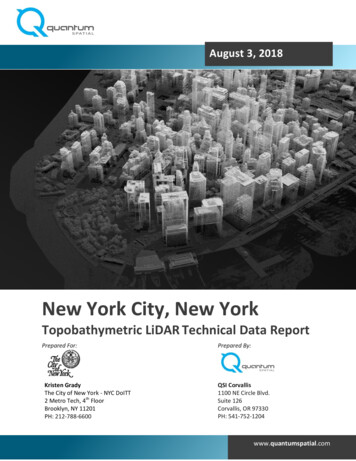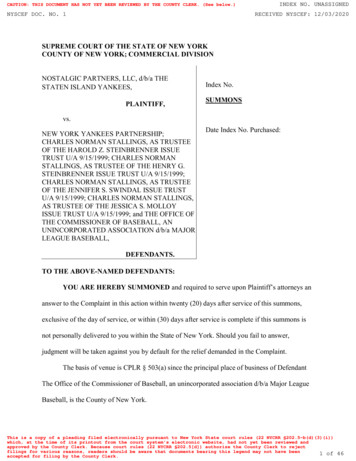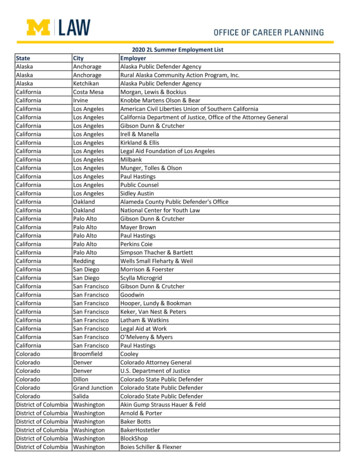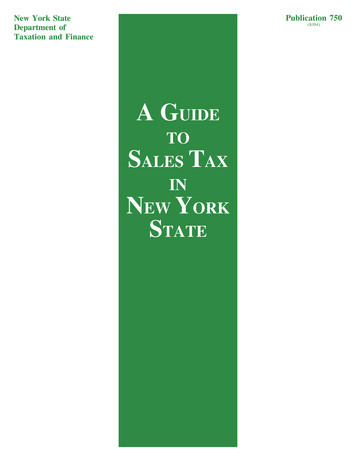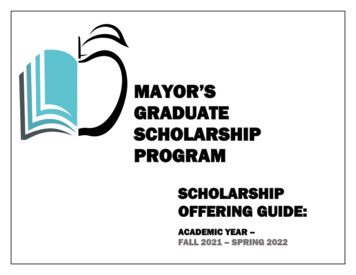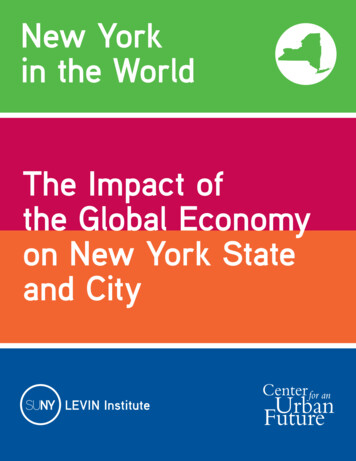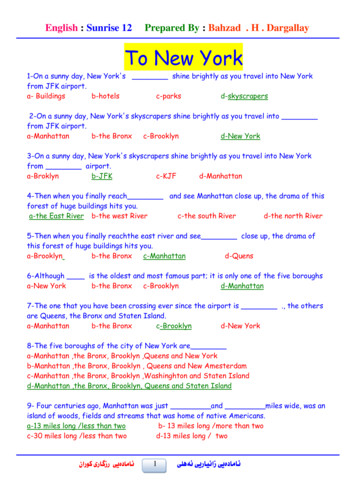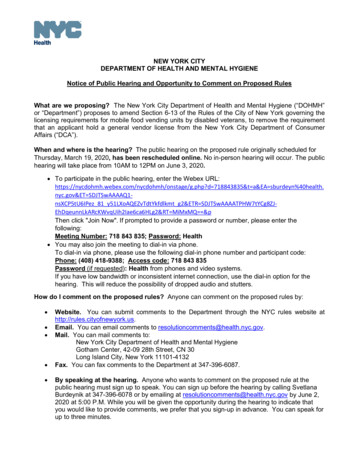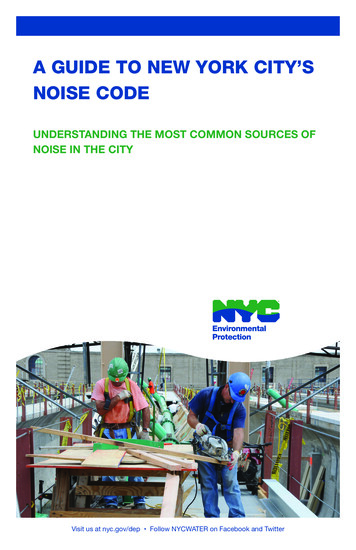
Transcription
A GUIDE TO NEW YORK CITY’SNOISE CODEUNDERSTANDING THE MOST COMMON SOURCES OFNOISE IN THE CITYVisit us at nyc.gov/dep Follow NYCWATER on Facebook and Twitter
NEW YORK CITY NOISE CODEThe New York City Noise Code balances the important reputation ofNew York as a vibrant, world-class city that never sleeps, with theneeds of those who live in, work in, and visit the city. In 2007 the Cityupdated the Noise Code for the first time in 30 years to reflect thechanging landscape and advances in acoustic technology.Simply put, the Noise Code was created to reduce:“The making, creation or maintenance of excessive and unreasonableand prohibited noises within the city affects and is a menace to publichealth, comfort, convenience, safety, welfare and the prosperity of thepeople of the city.”In order to enforce this objective, the New York City Departmentof Environmental Protection (DEP) and the New York City PoliceDepartment (NYPD) share duties based on the type of noisecomplaint. To report a noise complaint, call 311 and they will directyour grievance to the appropriate agency. For example, the NYPDhandles “neighbor to neighbor” noise complaints.This booklet is designed to provide an overview of the Noise Codeand some of the most common sounds of the city. For more detailedinformation about noise in the city and the law itself, please visit:www.nyc.gov/dep and follow DEP at www.facebook.com/nycwater.In addition, for educational modules relating to noise please visit:www.nyc.gov/dep/sound-education.SOUND MEASUREMENTSOverviewThe decibel (dB) is the universal unit of sound measurement and ismeasured with a meter that registers sound pressure and displaysthese readings on a sound level scale. Decibels are a logarithmic unit,which means that a noise measuring 30 decibels is actually two timeslouder than a noise registering at 20 decibels.One challenge of measuring sound in the city is that there is a highlevel of ambient sound, or background noise in an area. For example,Times Square has high ambient sound levels, making it harder todistinguish the source of a sound. The same sound in a residentialneighborhood may be easier to measure because there is lessambient sound.1Call 311 to report a noise complaint
Sounds of the CitySound levels vary depending on one’s distance from the noise source.Below are some frequently heard sounds and their approximatedecibel levels at common distances from the noise source. Whendesignated as “dB(A),” as seen below, the measurement is weighted inthe “A” scale to simulate human hearing.Whisper .Normal Conversation/Laughter .Vacuum Cleaner at 10 feet .Washing Machine/Dishwasher .Midtown Manhattan Traffic Noise .Motorcycle .Lawnmower .Train .Jackhammer/Power Saw .Thunderclap .Stereo/Boom Box .Nearby Jet Takeoff .30 dB(A)50 – 65 dB(A)70 dB(A)78 dB(A)70 – 85 dB(A)88 dB(A)85 – 90 dB(A)100 dB(A)110 dB(A)120 dB(A)110 – 120 dB(A)130 dB(A)CONSTRUCTION NOISEOverviewNew York City is involved in aconstant process of renovationand new construction. To limitconstruction noise, the Noise Codemandates that all constructionbe conducted in accordance withnoise mitigation plans that addressthe specific location, type of work,and timing of a project. The Codealso sets standards for noise levelscreated by handling containers andconstruction material on publicstreets, and ways to lessen thenoise from each type of constructionequipment. For example, jackhammers must be outfitted withnoise-reducing mufflers and/or have portable street barriersto reduce the sound impact on the area. The Noise Code alsodefines the hours when construction may occur.Call 311 to report a noise complaint2
HighlightsNoise Mitigation Plansk Contractors must develop a noise mitigation plan prior to thestart of work.kEvery construction site must have a noise mitigation plan onlocation.kIf noise complaints are received, an inspector will ensure thecontractor has posted the plan and that it is being followed. Thiswill determine whether or not the plan needs modification.kWhen construction activity is planned near locations such asschools, hospitals and houses of worship, the party responsiblefor construction is expected to design their noise mitigation planto be sensitive to its neighbors.Containers and Construction Materialsk Noise that exceeds the ambient sounds level by more than 10decibels as measured from 15 feet from the source as measuredfrom inside any property or on a public street is prohibited.kSounds that occur abruptly for a short duration, called impulsivesounds, are restricted.kA reduction of only five decibels usually makes a noticeabledifference to most complainants.Construction Hoursk Construction may occur between 7:00 am and 6:00 pm onweekdays.kAlterations or repairs to existing one- or two-family, owneroccupied dwellings, or convents or rectories, may be performedon Saturdays and Sundays between 10:00 am and 4:00 pm if thedwelling is located more than 300 feet from a house of worship.kWork may take place after hours and on weekends only withexpress authorization from the Departments of Buildings andTransportation. A noise mitigation plan must be in place before anyauthorization is granted.kEmergency work necessary for public safety, or work that cannotbe performed during normal work hours, may occur after hoursor on weekends. For example, water main or gas line repairsmay require construction activity outside the normal hours ofconstruction.3Call 311 to report a noise complaint
ANIMAL NOISESOverviewOwning a pet in New York requires increased responsibility to ensurethat pets are not disruptive. The Noise Code holds pet ownersaccountable for their animals’ noises, and owners must do their bestto limit noises so that their pets do not disturb their neighbors.Animal noises such as barking may indicate distress, danger, or anemergency situation, the Noise Code is designed to be flexible, andfirst complaints of excessive animal noise may lead to education.Information about reducing or better-controlling noise from an animalis mailed to the pet owner’s residence. When complaints persist,further action can be taken.HighlightsAnimal noise that is unreasonable and plainly audible from withinnearby residential property may call for enforcement action if the noiseoccurs:kAfter 7:00 am and before 10:00 pm for a continuous period of 10minutes or morekAfter 10:00 pm and before 7:00 am for a continuous period of fiveminutes or moreFOOD VENDING VEHICLESOverviewIce cream trucks traveling on city streets are a summer tradition, buttheir repetitious jingles can create a community nuisance and disruptnearby residents. Because enforcement can be difficult as truckstravel from neighborhood to neighborhood, DEP works with theDepartment of Consumer Affairs, which licenses vendors, to reminddrivers of their responsibilities under the Noise Code.Highlightsk The Noise Code prohibits the playing of jingles while any type offood vending vehicle is stationary. Vehicles may only play jingleswhile they are in motion.Call 311 to report a noise complaint4
AIR CONDITIONERS & CIRCULATION DEVICESOverviewPoorly maintained air conditioners can generate unnecessary,disruptive noise. Commercial and industrial air conditioners can beparticularly noisy due to their size and location on rooftops nearresidential buildings. The Noise Code restricts the decibel levelscreated by air conditioners and other types of circulation devices.HighlightsRestrictions:k A single circulating device may not produce noise levels in excessof 42 decibels, as measured three feet from the noise source at anopen door or window of a nearby residence.kTo account for the cooling needs of new construction or shiftingbuilding populations, the Noise Code limits buildings with multipledevices to a cumulative noise level of 45 decibels, as measured perthe above standard.Qualified inspectors may need to take several readings beforeenforcement can be deemed necessary.MUSIC FROM BARS & RESTAURANTSOverviewNew York’s world-renowned entertainment industry provides billionsof dollars in revenue to the city’s economy. The Noise Code attemptsto balance this vital economic necessity with residential quality-of-lifeconcerns through a flexible and responsive process.While DEP will often respond to residential complaints and schedulean inspection appointment to take meter readings, NYPD is morereadily equipped to respond to complaints in a timely manner due toits existing presence in local communities. All non-emergency noisecomplaints should still be directed to 311.The best way to reduce noise disturbances is to encouragebusinesses to change any offending operational practices. Gettingan offending business to come into compliance can be a challengebecause compliance may include physically changing a business’soperation or modifying sound equipment.5Call 311 to report a noise complaint
As an incentive for commercial noise violations to achieve compliance,the Commissioner may recommend to the Environmental ControlBoard that no penalty be imposed for a first offense if the businesscertifies that it has corrected the condition and provides satisfactoryand verifiable evidence of the correction. If the offending condition isnot remedied, multiple violations may result in penalties or sealing ofthe sound equipment.Highlightsk Commercial establishments that play music must limit the level ofunreasonable or disturbing noise that escapes into the streets or isheard in nearby residences by requiring that sounds levels may notexceed: 42 decibels as measured from inside nearby residences, AND 7 decibels over the ambient sound level, as measured on astreet or public right-of-way 15 feet or more from the source,between 10:00 pm and 7:00 amkSometimes residents are disturbed by pervasive bass sounds thatresonate and can be felt physically by a person. Bass sounds measurements are weighted in the “C” scaleand may not exceed 6 dB(C) above the ambient sound if theambient sound is greater than 62 dB(C).REFUSE COLLECTION VEHICLESOverviewThough the collection of refuse is critical to the health and safetyof city residents, noise from this process can be disruptive to localcommunities. To limit such disruptions, the Noise Code sets a moreenforceable standard in order to reduce unreasonable noise comingfrom refuse collection vehicles.Highlightsk Maximum sound levels may not exceed 80 decibels when measuredat a distance of 35 feet or more from the compacting unit of thevehicle when it is not engaged in compacting a load of refuse. ANDkMaximum sound levels may not exceed 80 decibels betweenthe hours of 11:00 pm and 7:00 am within 50 feet of a residentialproperty when measured at a distance of 35 feet or more from thevehicle when the compactor is engaged. Call 311 to report a noise complaint6
MOTOR VEHICLES & MOTORCYCLESOverviewEach day more than one million vehicles move through New YorkCity’s streets. The Noise Code addresses noise coming from vehicles,including motorcycles, and defines excessive sound.Highlightsk The Noise Code prohibits excessive sound from the muffler orexhaust of motor vehicles operating on a public right-of-way wherethe speed limit is 35 mph or less.kExcessive sound is: Plainly audible at a distance of 150 feet or more fromvehicles of less than 10,000 lbs. (cars); and Plainly audible at a distance of 200 feet or more fromvehicles of more than 10,000 lbs., (trucks); and Plainly audible at a distance of 200 feet from a motorcycle.kThe use of vehicle horns is illegal, except as a warning in situationsof imminent danger.kResidents may request an evaluation to determine if a “NoHonking” street sign would help.COMMON COURTESYOverviewA majority of the city’s noise complaints are reported as “noise fromneighbor.” By taking the few simple steps below, you can help createa more livable atmosphere for your community.kBe sensitive to your neighbor’s space and remember that oneperson’s ceiling is another person’s floor; try to keep noisy anddisruptive activities to a minimum.kKeep cell phone conversations to a minimum in public spaces,especially in confined areas like public transit.kKeep equipment levels down. Televisions, stereos, musicalinstruments should be used at a reasonable volume, to avoiddisturbing neighbors, especially at night and in the early morning.kUse power tools at appropriate times. Do as much as possible tostifle their noise and check specific regulations for their use.7Call 311 to report a noise complaint
Highlightsk The Noise Code specifically restricts the volume of car stereos inthe public right-of-way.kCertain machines, such as lawn mowers and leaf blowers, mayonly be used between 8:00 am and 7:00 pm (or until sunset,whichever occurs later) on weekdays; and between 9:00 am and6:00 pm on holidays and weekends.To report a noise complaint, call 311. For more detailed informationabout noise in the city and the law itself, please visit: www.nyc.gov/depand follow DEP at www.facebook.com/nycwater.Call 311 to report a noise complaint8
The New York City Noise Code is award-winning!Check out some of our awards:1. 2010 Safe-in-Sound Award2. 2009 ACEC Award for Engineering Excellence3. 2007 Noise Pollution Clearing House AwardGovernment Informationand Services for NYCNew York City Department of Environmental ProtectionBureau of Environmental Compliance59-17 Junction Blvd., 11th Fl., Flushing, NY 11373Printed on recycled paper 03/18Call 311 to report a noise complaint
Cll 311 to reort noise olint Highlights Noise Mitigation Plans k Contractors must develop a noise mitigation plan prior to the start of work. k Every construction site must have a noise mitigation plan on location. k If noise complaints are received, an inspector will ensure the contractor has posted the plan and that it is being followed.



